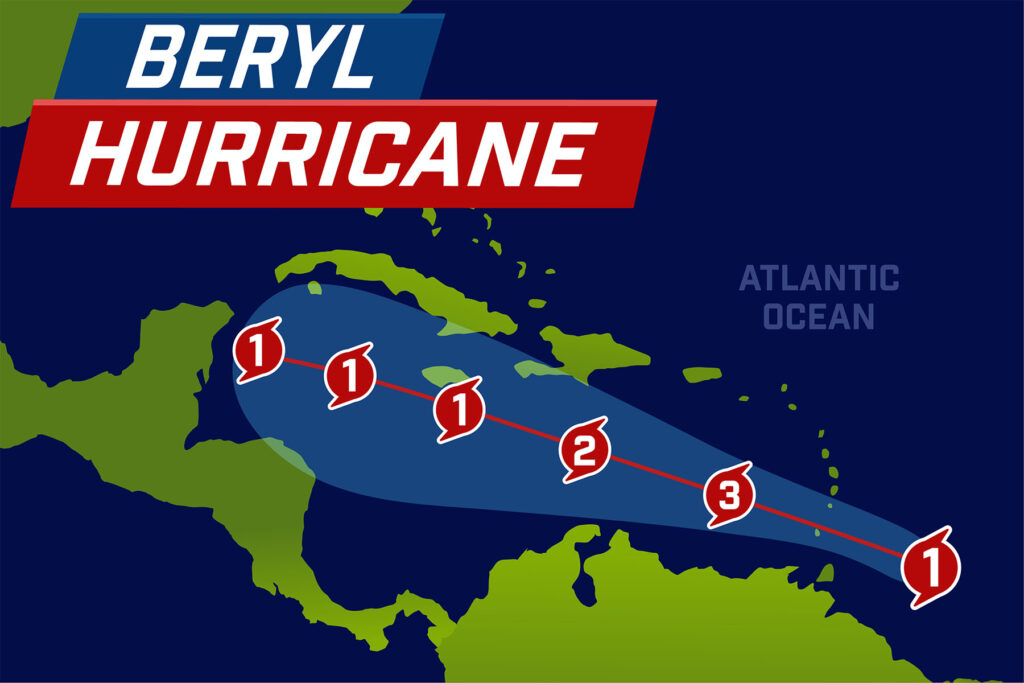Hurricane Beryl has rapidly intensified to a Category 5 storm, creating a critical situation for Jamaica and potentially threatening other regions in the Caribbean. The National Hurricane Center has issued urgent warnings for severe weather conditions, including high winds, torrential rain, and life-threatening storm surges. Here’s an overview of the current situation and the importance of a coordinated response.
Current Hurricane Situation
Hurricane Beryl is currently battering Jamaica with extreme winds exceeding 157 mph, heavy rainfall, and dangerous storm surges. The storm’s intensity has prompted widespread evacuation orders and significant concern for potential flooding and infrastructure damage. Emergency services are actively working to assist those in the storm’s path, coordinating evacuation and shelter operations to ensure the safety of residents.
The hurricane is expected to maintain its strength and may affect other Caribbean nations and possibly the southeastern United States in the coming days. The potential for widespread destruction necessitates a highly coordinated response effort among local, state, and federal agencies, as well as international aid organizations.
The Vital Role of Emergency Preparedness
In the face of such overwhelming natural forces, emergency preparedness is not just a precaution—it’s a necessity. Effective emergency response can significantly mitigate the impact of disasters like Hurricane Beryl. Here are some critical aspects to consider:
- Community Awareness and Education: Educating communities about the risks and the steps to take before, during, and after a disaster can save lives. Regular drills and public information campaigns ensure that everyone knows what to do when the worst happens.
- Robust Infrastructure: Ensuring that buildings, roads, and utilities are designed to withstand extreme weather conditions can reduce the physical damage caused by hurricanes and other natural disasters.
- Effective Communication Systems: Reliable communication channels are crucial during emergencies. They enable authorities to disseminate warnings, coordinate rescue operations, and keep the public informed.
- Emergency Response Plans: Having a well-documented and practiced emergency response plan allows for a swift and organized reaction when disaster strikes. This includes evacuation procedures, resource allocation, and coordination with local, state, and federal agencies.
- Investment in Technology: Modern technology, such as advanced weather forecasting, real-time monitoring systems, and emergency management software, plays a pivotal role in anticipating disasters and orchestrating responses efficiently.
The Importance of Coordinated Responses and Technological Solutions
Effective emergency response to hurricanes like Beryl requires seamless coordination and real-time information sharing. Technology plays a crucial role in enhancing these efforts, ensuring that responders have the tools and information they need to make informed decisions quickly.
- Real-Time Information and Communication: Advanced incident management systems like WebEOC enable responders to access real-time data and streamline communication across multiple agencies. This coordination is essential for managing evacuation routes, distributing resources, and keeping the public informed with accurate updates.
- Damage Assessment and Recovery Planning: Tools such as Crisis Track facilitate on-the-ground data collection, allowing emergency teams to rapidly assess the extent of damage and prioritize response efforts. Accurate damage assessments are critical for effective recovery planning and resource allocation.
- Predictive Analytics and Weather Forecasting: Integrating advanced meteorological data and predictive analytics through platforms like WeatherOptics provides emergency managers with precise weather forecasts and risk assessments. This capability helps anticipate the hurricane’s behavior and plan accordingly, ensuring timely and effective responses.
Enhancing Preparedness and Resilience
The experience with Hurricane Beryl highlights the need for continuous improvement in emergency preparedness and resilience. By leveraging advanced technology and fostering collaboration among various response agencies, communities can better prepare for, respond to, and recover from such devastating events. Equipping responders with the right tools and information is crucial in minimizing loss and accelerating recovery efforts.









